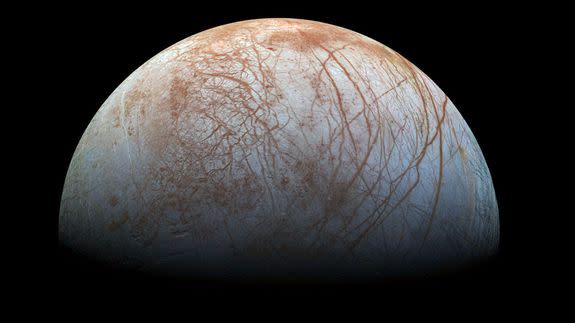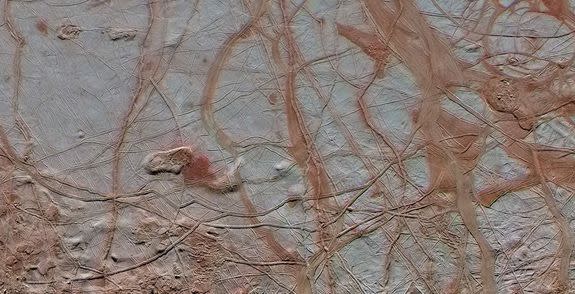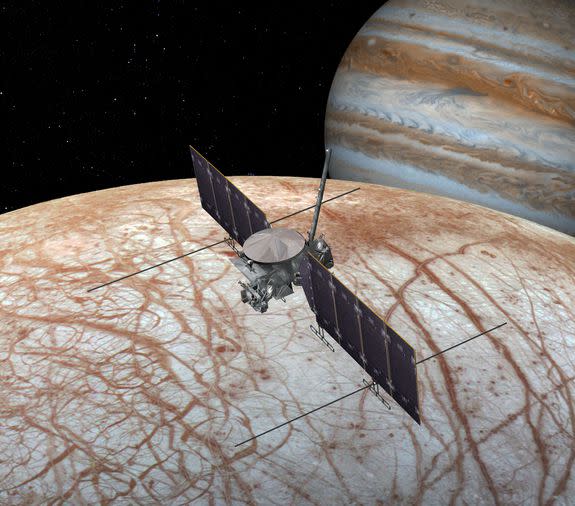3 facts and 1 big question about Jupiter's icy moon Europa

On Monday, NASA is set to reveal some new findings about Jupiter's moon Europa.
While the space agency did specify that the announcement will not involve aliens, scientists are itching to find out more about this special moon in an extreme part of the solar system.
SEE ALSO: 5 solar system worlds that are probably more watery than Mars
For years, scientists have used powerful telescopes and tools in space to learn more about Europa, but there's at least one big mystery left to solve.
Here are some of the big things we know and one huge question we still have about Jupiter's special moon Europa:
Europa has a lot of water
Europa most likely has a huge ocean of salty, liquid water below its icy surface, according to NASA.
NASA's Galileo spacecraft, which explored Jupiter in the 1990s, provided the evidence that led researchers to think that Europa probably has a large, salty ocean hiding underneath its crust.
Estimates suggest that Europa actually harbors more water beneath its surface than all of Earth's oceans combined. The liquid water is likely created by the tidal heating of Europa caused by Jupiter's immense gravity which flexes and contracts the moon in its orbit.

Image: NASA
Some researchers now think that the brown streaks on Europa's surface might be irradiated salts that have bubbled up from the ocean, making it out onto the moon from below thanks to some kind of geological process.
Scientists are particularly interested in the watery places in the solar system because life as we know it requires water. Because Europa appears to play host to quite a lot of the wet stuff, the moon is considered one of the best places to hunt for life in the solar system.
"I think there's a good chance that Europa has lots of good stuff for life going into its ocean," NASA scientist Steve Vance, who studies Europa, told Mashable in an interview.
It isn't the only interesting, icy moon
And Europa isn't alone.
Other icy moons orbiting giant planets also have potentially habitable oceans beneath their shells. Saturn's moon Enceladus and Jupiter's Ganymede are also thought to have liquid water reservoirs.
The Cassini spacecraft even flew through one of Enceladus's plumes of icy water to get a taste of the alien ocean's water flying off into space. Scientists still haven't released the results of that experiment, but if the water's chemical balance is similar to Earth's it might be a nice place for at least microbial life to develop.
"I'm excited in general that there are multiple ocean worlds in the solar system," Vance said. "I'm most excited about Europa because of the unique chemistry that it has and the high amount of energy it appears to have."
We want to go to there
NASA will hopefully start gathering more information about Europa in the not-too-distant future when the space agency sends a spacecraft to make a series of flyby of the moon.
"The mission plan calls for a spacecraft to be launched to Jupiter in the 2020s, arriving in the distant planet’s orbit after a journey of several years," NASA said in a 2015 statement when the mission was first approved.

Image: NASA
"The spacecraft would orbit the giant planet about every two weeks, providing many opportunities for close flybys of Europa. The mission plan includes 45 flybys, during which the spacecraft would image the moon's icy surface at high resolution and investigate its composition and the structure of its interior and icy shell."
The flyby mission does have its limitations, however. According to Vance, this mission will not address exactly how the ocean functions, but it will give scientists a better understanding of how Europa works generally.
"It's going to map the entire surface of Europa and reveal what its geology is hinting at in terms of how the ice is overturning," Vance said. This information should give scientists a better understanding of what kinds of materials could be in the moon's ocean, potentially bolstering odds for life.
Scientists also hope to one day launch some kind of lander that could explore Europa from the surface, perhaps even sending a small submersible beneath the crust and into the ocean below.
Does it have life?
Eventually, if NASA or any other space agency, gets a taste of Europa's ocean, it will become clear if the moon does alien life of some kind within it, but until then, scientists will be left guessing.
Perhaps the biggest question Vance and other researchers have about Europa is whether or not the moon's ocean is habitable.
"I personally want to know the composition of the ocean. I think that's strongly tied to life," Vance said.
There is already some evidence that Europa's moon might be habitable.
An earlier study showed that Europa's ocean could be friendly for life without the presence of volcanic activity on its seafloor. According to the study, produced by Vance and a team of researchers, the world could play host to oxygen and hydrogen in amounts comparable to those on Earth.
